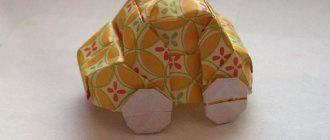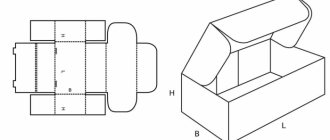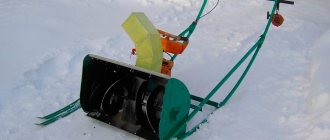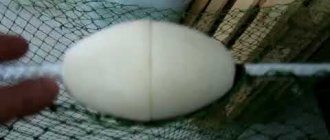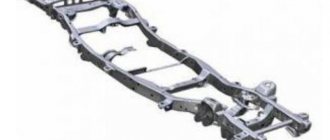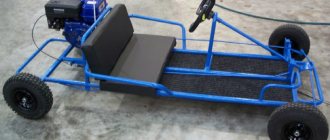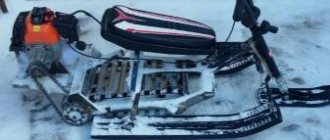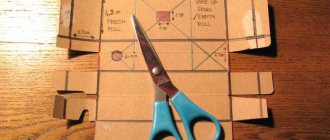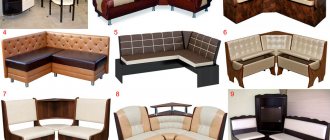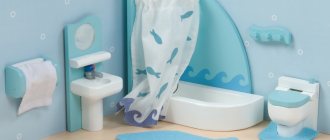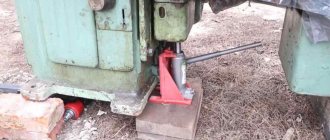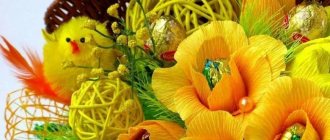If children need to be occupied for a long time and distracted from the TV or mobile gadgets, there is nothing better than an origami paper zoo. Animals are one of the most attractive subjects in images; they evoke positive emotions and encourage creativity. Also, by creating paper animals and birds, children remember information about natural prototypes much better. A ready-made origami zoo can easily be turned into a tabletop theater, acting out scenes with its inhabitants. Depending on the age of the child, you should choose models of varying complexity, but it is desirable that the figures are realistic.
Tiger
The largest representative of the cat family is in almost every zoo. It impresses with its power, size, graceful plasticity and characteristic colors. Interestingly, not only the predator’s fur is colored with stripes, but also its skin. If someone decides to shave a tiger's head, after a while the colored hairs will grow back in the same order. The stripes of each animal are individual; their pattern, according to scientists, is not repeated.
In addition, each individual has a specific tone of voice, by which predators recognize each other. When angry, tigers do not growl, but hiss like domestic cats. And they are also capable of purring if they are in a good mood. A tiger rarely attacks a person, and if it does, it tries to do it from behind. Therefore, in Indian zoos, keepers put a mask with a face on the back of their heads, deceiving the predator.
The paper tiger will not attack - it can be folded slowly, as carefully as possible.
You will need:
- 2 squares of orange or yellow paper 21x21 cm;
- scissors;
- glue stick;
- black marker.
The figurine is an origami of medium complexity. It is created based on the basic form “Bird”.
Step-by-step instruction:
- We divide the square with four main fold lines: diagonal and longitudinal-transverse. To do this, we consistently fold it in half and open it.
- We bring the extreme points to the center and press the lowering valves. It turns out to be a “Double Square”. We place its free end down and to the right.
- We bend the side corners of the layer closest to us towards the middle. Lower the top triangle. Open up the folds you just made. Raise the bottom point up until it stops, press the sides, aligning them along the vertical axis.
- Turn the figure over and repeat step 3 on the reverse side.
- Let's start making the head and front paws of the tiger. We place the “Bird” with the free ends facing us. Fold them up and to the sides. Make a fold in a different direction. Using a reverse fold, we bring the ends inward.
- We bend the figure in half vertically “mountain-wise”. We turn the workpiece so that the free ends, which will become tiger paws, are at the bottom. On the left side we make a reverse fold, but not inward, but outward - “valley”.
- We fold the upper part of the figure down, forming the head of a tiger. We bend the bottom point - we get a “chin”. We make small slits in the top layer at the “back of the head”. Raise the points up and out to form ears.
- From the second square we assemble the back. We start again with the basic “Bird” shape. We turn the model with the open ends towards us. We fold them according to the same algorithm as the front “legs”. We position the workpiece with the massive end to the left. And flip the top layer to the right. At this point, the tiger's tail begins to form.
- We fold the sides of the right side towards the center, slightly short of it. Smooth out the resulting folds well.
- Fold the leftmost point to the right so that it touches the opposite multilayer part of the model.
- We bend the workpiece in half “mountainwise” horizontally.
- We connect both halves of the animal by inserting the protruding parts of the front into the lower “pockets” of the back. It’s better not to stop there and glue them together additionally. Using reverse folds, we give a curved shape to the paws and tail.
We draw stripes and a face for the tiger to make it look more realistic.
DIY ZOO in a box for your daughter
Hello everyone, girls! Recently, one of my friends here showing cardboard templates for a zoo gave me the idea to make something similar for my daughter. I wanted a zoo just like a real one, in a box, with enclosures, paths, a ticket office, and landscape design. So that it’s not babyish, but closer to the real thing in appearance. There were already a lot of living creatures. All that remained was to find such a set. Alas, I didn’t find anything like that on the Internet, and what I found was worth a lot of money... I had to make it myself) A year ago I made a dollhouse for my daughter her size from cardboard boxes, and now I decided to make it using the same technology)) In the end A cool laptop box caught my eye, I modified it so that it could fold out and, if necessary, fold. I reinforced it with layers of corrugated cardboard, covered it with a film with a pattern of a stone path, covered it with scrap paper with a pattern of a FENCE FROM BOARDS, and used a lot of scrap materials.
In general, maybe someone will find my idea useful, because I couldn’t find anything like it on the internet.
And this is what happened:
The height of the fences is not higher than the sides, and therefore nothing wrinkles or breaks when folded. The walls turned out to be thick. All the grass in the enclosures is fixed price artificial grass platforms. Fences - wooden skewers for shish kebab and jute twine.
Well, and the views of the zoo itself without the animals: everything as it should be, a sign, a ticket office, an information stand at the entrance.
The entire ZOO is divided into two zones: the forest animals zone and the exotic animals zone.
In the enclosures I wanted to do everything like the animals in life: a camel has a desert, cacti, a bear has a den, etc. So that the ZOO also has a developmental function, to study animals and their habitats, what they eat, etc.
Wolf and bear enclosure:
Enclosure of a camel and an ostrich DESERT: a camel eats sticks (near a stone), a cactus grows in the desert. The desert itself is made from Kraft wrapping paper.
Next is the GLACE aviary, for a white bear, a penguin, and pinnipeds: ICE made of polystyrene foam from a box, water - I dug out a couple of layers of corrugated cardboard, glued blue shoe covers, it turned out in relief like waves.
Aviary POND, for duck, beaver and otter, with a beaver hut (made of twigs):
Next, an enclosure of feline predators: a relief made of corrugated cardboard in the form of slabs, bushes, stones, boulders
We also had mini figurines of sea creatures; we had to make an aquarium out of a doll’s box, with a transparent plastic film:
Panda and koala enclosure:
Well, with our little animals:
Well, the children’s first excursions:
I also had to make food for the animals from the playground. This is how we taught who eats what: boars, for example, worms, branches, etc., bears, fish, raspberries, elephants, bananas, squirrels, berries, acorns, mushrooms, etc.:
That's how it happened! In general, just like with the dollhouse, it really sucked)) And even I became interested in reading about the animals, it turned out I don’t know much about who eats what, for example, otter, beaver, ostrich, etc. So all that remains is for us to buy an encyclopedia about animals for our general development)
Giraffe
After the largest land predator, it is worth moving on to the herbivorous giant. His life begins with a fall from a 2-meter height, as the mother gives birth to her babies while standing. Adult giraffes grow up to 6 m, with 1/3 of the total body length coming from the neck. Despite their two-ton weight, African giants run well, reaching speeds of up to 50 km/h. Although even with normal walking it is not easy to catch up with them, because with each step the animal covers a distance of 4 m.
Giraffes devote almost a full day - from 16 to 20 hours - to eating. Which is not surprising given such colossal dimensions. If males and females approach the same tree, they stand on different sides of it so as not to interfere with each other during “lunch.” This does not mean that giraffes are completely peaceful and never clash with each other. But relationships are sorted out mainly by males during the rutting period. They arrange a kind of arm wrestling, using their powerful, muscular necks instead of arms. But these herd animals do not fight for territory; moreover, they willingly accept strangers.
The river is an insurmountable obstacle for the tallest creatures in the world. Due to their thin legs and heavy weight, they cannot move on muddy soil. Having encountered a swamp or other body of water on the way, giraffes are forced to turn back.
Zoos are as rarely without the charming herbivorous giants as they are without tigers. Therefore, you must make them for your origami collection. Moreover, the model belongs to the category of simple ones.
Master class “Zoo made of cardboard”
Natalya Krivonos
Master class “Zoo made of cardboard”
Colleagues, I bring to your attention a master class on making animals for a mini “ zoo ”
.
For work we will need the following materials:
1. Cardboard in gray , green, yellow colors.
3. Markers.
Kangaroo
When Europeans first saw an animal endemic to Australia, they thought it was a creature with two heads. In fact, it was a female with a baby hiding in her pouch. If the giraffe became famous for its height, and the tiger for its size, the kangaroo has its own records. And these are not jumps at all, although they are impressive, reaching 12 m. Baby kangaroos, when compared with the size of an adult animal, are rightfully considered the smallest in the world. Newborns do not exceed 25 mm in length; they can fit in a walnut shell. The bag is a kind of incubator where babies grow stronger and gain strength within six months. Only then do they come out.
The most powerful part of a kangaroo’s body is its tail; it protects from enemies, serves as a support, and allows it to maintain balance. Unlike many other runners, when marsupials gain speed, they do not increase, but rather decrease, the load on their muscles. That is, the faster they jump, the more comfortable they feel.
Kangaroos thrive in zoos and often breed in captivity. Why not make a figurine of this unusual animal out of paper? The origami model is based on the same “Bird”. To make it you will need a square sheet of 21x21 or 15x15 cm.
What we need:
- cardboard;
- two foil sleeves;
- pebbles for wall decoration;
- artificial plants;
- wooden skewers;
- glue gun;
- figurines of children and animals;
- scissors;
- White paint;
- paint brush;
- water for the brush;
- stickers or pictures of animals;
- white sheet of paper;
- markers;
- green colored paper;
- gray colored paper.
Big panda
Bear or raccoon? Until now, the giant panda cannot be unambiguously attributed to one or another family. This is an extremely rare and secretive animal, whose lifestyle has been little studied by specialists. However, in zoos, bamboo bears are so in need of human attention that a unique profession has even emerged as “panda cuddlers.” Zookeepers come to the cub sites and, like a caring mother, nurse the cubs, which are kept separately from the adults. It is believed that lack of attention at a young age will subsequently prevent pandas from feeling confident and adapting to the world around them.
In general, bamboo bears fully justify their contrasting black and white color - they consist of continuous contradictions. They are an endangered species, but reproduce very selectively. The mother feeds only one cub, but the second, due to lack of nutrition, dies. In nature they are unsociable, but in captivity they become very attached to those who care for them. They have come a long way of evolution, but they are very vulnerable and now, due to a violation of the ecological balance, they have ceased to develop as a species.
People have brought bamboo bears to the brink of extinction, and they are actively reviving the almost lost population. China has established, so to speak, “in-line production” of giant pandas. Zoo workers leave the first, stronger baby to the mother for natural feeding, while its weaker brother is raised under artificial conditions. Thus, the Chinese panda population is rapidly increasing.
There are other bears in the collection of origami models that are also interesting to make with your own hands.
Double-sided design for gaming
The idea of such a large-scale game is easy to implement if you follow the recommendations of the article. We have prepared a detailed description of the work progress and a list of everything that will be needed. Who knows, maybe your baby will become the new Gerald Durrell - a world-famous scientist and honorary doctor of science, who saved many rare animals from extinction.
Gorilla
The largest crowds at the zoo gather around the ape enclosures. Watching primates is really interesting. Especially gorillas, which are very close to humans at the genetic level, second only to chimpanzees. They are considered the most powerful among primates: an adult male often grows up to 2 meters and weighs 140 - 180 kg. Even large predators like leopards are afraid to attack gorillas, since the outcome of such a fight is difficult to predict.
The intellectual abilities of great apes are also excellent. For a long time, the gorilla Coco lived at the San Francisco Zoo, who managed to learn sign language and spoke entire phrases in it. Moreover, as scientists have proven, this was not a simple imitation. They try to constantly train the intelligence of primates kept in captivity, otherwise the animals feel uncomfortable. So at the Moscow Zoo, keepers hide small delicacies like dried fruits and seeds in the hay so that the gorillas will later look for them - a real quest for the “little brothers.”
Hippopotamus
Unlike primates, the hippopotamus is not one of the intellectuals of the animal world. In numerous rankings of the “smartest mammals” it is traditionally given last place. But the head of hippopotamuses, relative to the general proportions of the body, is the largest. Half is occupied by the mouth with jaws, which, when closed, press on the victim with a force of 230 kg.
An adult hippopotamus can easily bite a young crocodile. It is no less dangerous for humans. Despite its apparent inactivity, on land the hippopotamus is capable of reaching speeds of up to 30 km/h. True, he does not run for long, but this is enough to overtake the victim. In nature, the water moth has almost no enemies, except for humans, to whom the animal pays in the same coin. On African reservations, it is hippos, and not lions or crocodiles, that become the most common cause of death for tourists.
It is best to observe the animal from a safe distance in zoos. Here the hippopotamus looks phlegmatic and not at all aggressive. Just like his image using the origami technique.
How to prepare for an origami lesson
Of course, to create paper figures, you will first need paper of several colors. It is better that it is not very thin - firstly, it is easier to work with thick paper, and secondly, crafts made from it retain their shape for a long time.
In addition to paper, you need to prepare:
- ruler - with its help it is convenient to fold or tear sheets evenly, as well as measure the required distance;
- scissors;
- a pencil will be needed to mark the fold or cut line;
- colored pencils, paints, felt-tip pens for coloring finished crafts;
- diagram;
- accessories for decoration - beads, ribbons, eyes for animals and everything that your imagination suggests.
An origami “Animals” pattern suitable for children should be chosen in accordance with their skills and capabilities. A job that is too easy will not bring satisfaction, and if the pattern is too complex, the child may even refuse to complete the craft.
Pelican
Unusual birds with a huge sac beak are frequent inhabitants of zoos. Under natural conditions, they nest on the banks of freshwater and salt water bodies. They feed on fish, which they catch with their beaks as if in a net. In one “approach”, a pelican is capable of scooping up to 12 kilograms of food mixed with water.
The beak is impressive not only in appearance, but also in weight. It is the heaviest part of the pelican's body. The skeleton of birds is so light that they cannot dive into the water and fish only on the surface. In flight, pelicans have to bend their necks in an S shape so that their head rests on their body. Despite these disadvantages, they are able to cover long distances during seasonal migrations.
Pelicans live in large flocks of up to 10,000 individuals. Like penguins, they hand over their chicks to public nurseries when it's time to go hunting. When feeding young animals, parents push semi-digested fish out of their beaks - a kind of adapted “baby food”. From the outside, it seems as if pelicans give their insides to their chicks, which is why in ancient times birds were revered as a symbol of sacrifice and maternal self-denial.
Furry animals
After the predators, I want to make some cute crafts. Therefore, it would be appropriate to describe the procedure for assembling an origami cat from paper.
Making animals (scheme of work).
- Prepare a sheet of paper. To do this, roll it diagonally twice (Illustration 1).
- Flatten the sheet and tuck the top and bottom corners to its center line (Illustration 2).
- Bend the lower and upper right parts a few millimeters (Illustration 3).
- Turn the figure over (Illustration 4).
- Fold the bottom and top of the right side of the part to the fold line (Illustration 5).
- Tuck half of the figure (Illustration 6).
- Unscrew the top half (Illustration 7).
- Wrap the “wings” of the part, as in illustration 8.
- Straighten the “nose” of the figure, as in illustration 9.
- Fold the bottom triangle (Illustration 10).
- Tuck the “ears” on both sides (Illustration 11).
- The top part should also be removed back (Illustration 12).
- Fold in part of the bottom triangle as shown in illustration 13.
- Spread the “wings” of the lower triangle (Illustration 14).
Draw the kitten's face (eyes, mouth, nose, antennae). If you wish, you can add a forelock.
The craft is ready!
